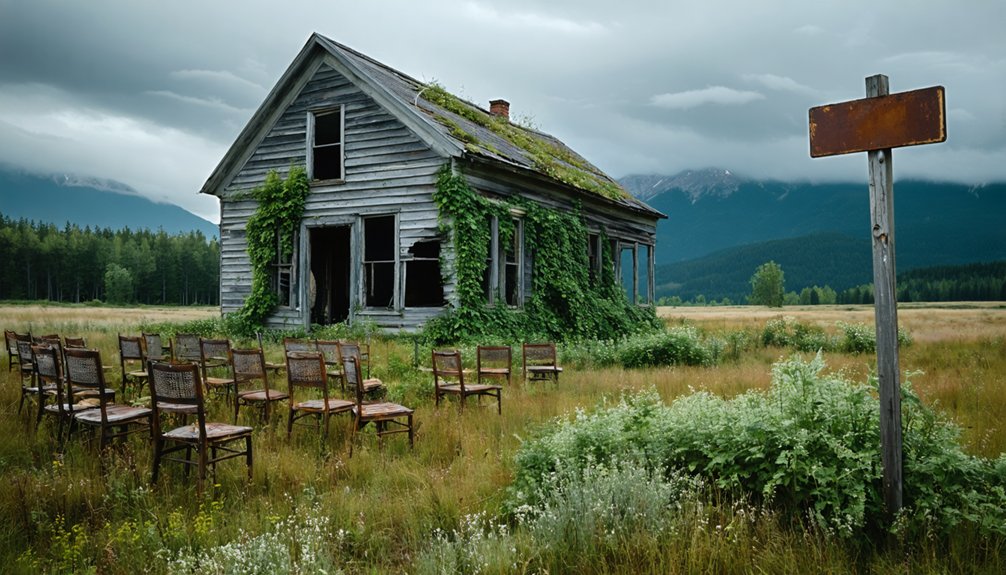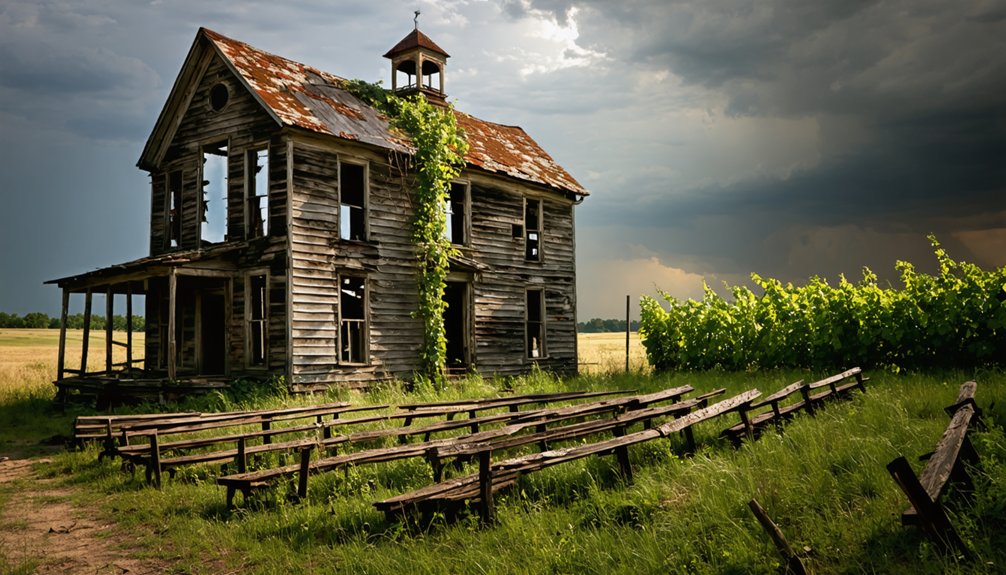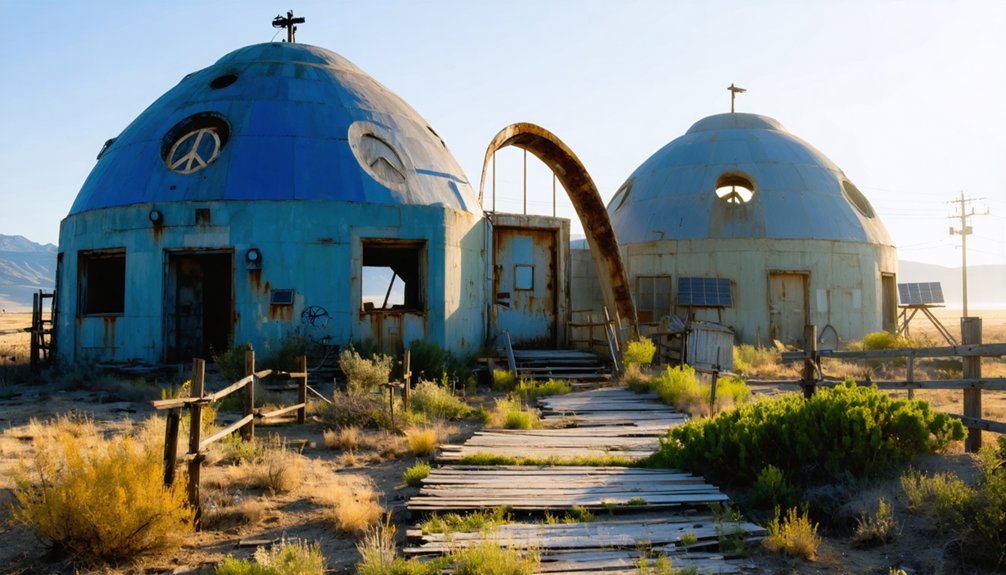American utopian colonies failed through predictable patterns: charismatic leadership without succession plans, unsustainable economics, and intense social pressures in isolated environments. You’ll find that most communities collapsed when ideological fervor couldn’t overcome practical challenges of resource management and interpersonal conflicts. Religious experiments like the Shakers and secular ventures like Brook Farm ultimately suffered from similar governance issues and financial instabilities. Examining these historical experiments reveals cautionary insights for modern community builders.
Key Takeaways
- Unsustainable economic models and communal property systems often undermined productivity and resource management in utopian colonies.
- Charismatic leader dependency created governance vulnerabilities and succession crises when founders died or became autocratic.
- Environmental challenges including geographic isolation and resource scarcity directly contributed to community collapse.
- Rigid moral codes and social experiments caused interpersonal conflicts that were amplified by communal living arrangements.
- Ideological fervor frequently couldn’t overcome practical realities of maintaining self-sufficient communities outside mainstream society.
The Push Against Industrial Capitalism: Origins of American Utopias
As industrial capitalism surged through early 19th-century America, it left profound social dislocations in its wake, prompting idealists to envision and build alternative communities free from its perceived evils.
Idealists confronted capitalism’s chaos by building communal havens where cooperation replaced competition and profit.
You’ll find these utopian colonies emerged specifically as reactions against the harsh realities of wage labor and growing urban squalor. Their founders rejected competitive individualism in favor of utopian principles based on cooperation and shared resources. Many of these communities were influenced by evangelical Protestantism and the religious fervor of the Second Great Awakening. The distinction between religious and ideological utopias became a critical factor in determining their longevity and economic sustainability.
Communal living arrangements eliminated the social hierarchies tied to capital ownership while attempting to create classless societies. These communities attracted diverse participants—intellectuals, artisans, laborers, and even disillusioned capitalists—all seeking escape from market-driven alienation.
The American frontier provided perfect geographic isolation for these experiments, allowing founders to establish “clean slates” where cooperative economics could flourish beyond capitalism’s reach. Their communitarian farms and collective production systems directly challenged the foundations of private ownership and wage dependence.
Religious Fervor and Social Reform: Founding Ideologies
You’ll find that religious persecution in Europe drove many utopian founders to America, where they established colonies based on divine revelation and scriptural interpretation.
Their radical reimagining of society typically rejected industrial capitalism in favor of communal property and collective labor systems.
These communities often developed in tension with mainstream society, as their religious practices—whether celibacy among the Shakers or the communal marriage system of Oneida—challenged conventional social norms and economic structures. The Amana Colonies exemplify this pattern, having relocated from Germany to New York and eventually Iowa seeking religious freedom after facing persecution for refusing military service and conventional schooling. The First Amendment’s freedom of religion guarantee provided constitutional protection for these experimental communities to practice their unique beliefs.
Divine Perfection Pursued
While the American frontier offered vast physical landscapes for settlement, it was the spiritual frontier that drew many utopian communities to establish their “heavens on earth.”
Religious fervor served as the primary catalyst for numerous utopian experiments in 19th-century America, with groups like the Shakers, Rappites, and Inspirationists viewing their communal endeavors as divinely ordained missions.
These colonies operated under direct divine inspiration, implementing radical practices like celibacy, communal property, and separation from mainstream society. The Ephrata Cloister in Pennsylvania, founded in 1732, maintained its monastic community structure for over two centuries until 1934.
Their spiritual aspirations translated into distinctive social structures where daily life, governance, and education centered around religious doctrine.
You’ll find that these communities often viewed themselves as fulfilling biblical prophecy, creating a “New Jerusalem” where human perfection could be achieved through strict adherence to their interpretation of God’s will.
Radical Social Reimagining
The radical social reimagining that characterized America’s utopian colonies extended far beyond mere religious devotion, encompassing extensive visions for restructuring human relationships and society itself.
You’ll find that communities like Oneida and Brook Farm deliberately rejected conventional social structures, experimenting with alternative models of marriage, property ownership, and governance.
These colonies pursued radical ideals through practical experiments—abolishing private property, implementing communal child-rearing, and promoting women’s rights decades before mainstream acceptance.
Their leaders often coupled religious fervor with progressive social reform, creating thorough systems meant to address humanity’s moral and material needs simultaneously.
These utopian communities employed cooperative enterprises as their economic foundation, blending religious and ideological principles to create self-sustaining social systems.
Community cohesion depended on members’ willingness to abandon entrenched social norms.
While this commitment enabled bold experimentation, it also limited growth and ultimately contributed to many colonies’ dissolution when external pressures mounted against their unconventional lifestyles.
Many utopian colonies collapsed precisely because they lacked strong social ties or religious foundations that could sustain them through economic and social challenges.
When Communal Economics Collapse: Financial Failure Patterns
Despite the idealistic foundations upon which they were built, America’s utopian colonies frequently collapsed under the weight of economic reality.
You’ll find that most failed due to unsustainable economic models paired with poor resource management.
Communities like Llano del Rio crumbled when facing resource scarcity and insufficient financial oversight. Without proper incentives, productivity decline became inevitable as communal enthusiasm waned.
Idealistic communes confronted harsh realities when resources dwindled and financial systems proved inadequate for sustaining collective productivity.
Labor incentives diminished under shared ownership structures, while market isolation prevented meaningful economic growth.
External pressures compounded these weaknesses—utopian enterprises simply couldn’t compete with profit-driven businesses.
Structural constraints, from limited credit access to inadequate skilled labor, further undermined sustainability.
Mining-based communities demonstrated this pattern vividly, with less than 5% of miners actually achieving the wealth they had desperately sought.
When examining these failures, it becomes clear that ideological fervor rarely overcame practical economic challenges, as cash flow problems typically preceded social disintegration.
Similar to how Keynes advocated for state intervention to save capitalism during economic crises, these colonies often sought external funding to survive.
Leadership Dynamics and Power Struggles in Failed Communities
You’ll find that many utopian communities collapsed when their charismatic founders either died or became corrupted by unchecked authority.
The concentration of power in a single leader often transformed idealistic visionaries into autocratic rulers who stifled dissent and created disenfranchised factions.
These governance failures reveal how even the most promising communal experiments faltered without transparent leadership structures and clear succession plans. Communities that lacked fair, participatory governance processes and conflict resolution mechanisms were particularly vulnerable to collapse, as structural conflict emerged as a major reason for community failure.
Charismatic Leaders’ Downfall
Charismatic leadership within American utopian colonies often contained seeds of its own destruction, creating patterns that would eventually undermine the very communities these influential figures worked to establish.
You’ll find that centralized authority, while initially fostering strong group cohesion, ultimately prevented institutional stability beyond the founder’s tenure.
Leaders like John Humphrey Noyes and Jim Jones cultivated intense follower loyalty through their magnetic personalities, but this dependence proved catastrophic when scandals or succession crises emerged.
Their manipulation of devotees—particularly through isolation tactics and claiming divine authority—enabled exploitation while suppressing dissent.
When these leaders departed or fell from grace, communities typically fractured along factional lines, lacking the democratic processes necessary for continuity.
The trajectory followed a predictable arc: charismatic recruitment, rapid growth, abuse of unquestioned authority, and eventual collapse when leadership changes failed.
Concentrated Power Corrupts
Beyond the individual failings of charismatic founders, systemic issues emerged in concentrated power structures that undermined many American utopian experiments.
You’ll find that communities where authority consolidated in few hands consistently developed troubling power dynamics. Without robust accountability mechanisms, leaders often drifted toward authoritarian decision-making, stifling dissent and alienating members.
This authority misuse created dependency cultures where individual initiative withered. When leadership conflicts erupted—as they inevitably did—factional rivalries consumed resources and fractured communal goals.
The consequences were predictable: communities experienced membership decline through desertion and expulsions. Governance structures weakened as power struggles intensified, ultimately leading to dissolution.
The historical record shows a clear pattern: when communities failed to establish transparent, participatory structures to balance power, corruption and internal strife invariably followed, dooming even the most idealistic ventures.
Environmental Challenges and Geographic Isolation

While many utopian communities set out with idealistic visions of self-sufficiency and harmonious living, the harsh realities of environmental challenges and geographic isolation often undermined their sustainability.
Water scarcity plagued colonies like Llano del Rio, where chronic shortages and legal disputes over water rights led to their demise. Geographic remoteness intensified these ecological challenges, limiting access to markets, medical care, and innovation when crises struck.
You’ll find that resource competition became more severe in isolated settings, amplifying social tensions when supplies dwindled.
Environmental degradation from settlers’ practices—deforestation, river diversion, and mining—damaged the very ecosystems these communities depended on.
Infrastructure limitations and poor soil fertility further compromised agricultural sustainability. The isolation effects were profound: when drought, fire, or disease struck these remote settlements, they lacked the external support needed to recover.
Social Exclusion and Moral Conflicts: The Human Element
The interpersonal dynamics within utopian communities often proved more destructive than external threats, revealing how social exclusion and moral conflicts undermined even the most idealistic ventures.
You’ll find that class divisions emerged as productive members resented supporting those perceived as idle, creating exclusionary practices that contradicted egalitarian principles.
Ideological tensions manifested through rigid moral enforcement, as strict adherence to Fourierist or Owenist doctrines stifled individual autonomy.
Communities filled with incompatible personalities—former ministers alongside bankrupt merchants and artists—struggled to forge a coherent communal identity.
The psychological impact of these interpersonal conflicts was profound, magnified by isolation and disrupted social networks.
Despite countless constitutional rewrites and impassioned speeches, cooperative failures persisted because procedural solutions couldn’t resolve the fundamental social dynamics tearing these experimental societies apart.
Physical Remnants and Cultural Legacies of America’s Failed Utopias

America’s failed utopian experiments haven’t disappeared entirely from the landscape, but instead persist as scattered physical remnants and cultural memories across the nation.
You’ll find California Historical Landmark No. 933 marking Llano del Rio, though its structures have vanished—ransacked by neighbors for building materials after abandonment.
These ghostly settlements live on through historical markers and preserved sites like Brook Farm, a National Historic Landmark with just one surviving building.
La Réunion’s weathered cemetery stones tell silent stories of socialist dreams in Dallas.
Local cultural memory persists through oral histories shared by descendants and community storytellers, while academic databases and literary works document these ambitious failures.
Despite their physical dissolution, these communities continue to occupy significant space in America’s collective consciousness—reminders of alternative visions for society.
Frequently Asked Questions
How Did Utopian Communities Address Healthcare and Medical Emergencies?
You’ll find utopian communities managed healthcare through internal communal resources, with volunteer-based clinics and free medical attendance. Their limited medical practices included quarantine during epidemics, collective caregiving, and preventative measures despite resource constraints.
What Happened to Children Born Within Failed Utopian Colonies?
You’d find children faced foster homes or orphanages after colony collapse, losing communal support networks. Their childhood experiences often included upheaval, displacement, and later challenges with social integration into mainstream society.
How Did Utopian Communities Handle Romantic Relationships and Marriage?
You’ll find utopian communities handled relationships through three main approaches: complex marriage systems, strict celibacy, or individual freedom—each attempting to resolve communal living tensions through radically reimagined relationship dynamics.
Did Failed Utopian Colonies Maintain Contact With Former Members?
Like texting friends, you’d find failed utopian colonies maintained contact with former members through various communication methods—letters, newsletters, and reunions—preserving emotional connections despite geographic and ideological distances.
How Did Technology Adoption Differ in Utopian Communities?
You’ll find utopian communities selectively adopted technologies supporting communal resources while rejecting industrial systems. Fourier-influenced phalansteries embraced educational technology but resisted telegraph and railroad integration that threatened self-sufficient ideals.
References
- https://www.mentalfloss.com/history/failed-utopias
- https://guides.loc.gov/chronicling-america-early-utopian-communities
- https://fee.org/articles/the-dark-side-of-paradise-a-brief-history-of-americas-utopian-experiments-in-communal-living/
- https://www.uhd.edu/documents/provost/us-history.pdf
- https://www.yesmagazine.org/health-happiness/2022/06/01/american-communes-failed-experiment
- https://en.wikipedia.org/wiki/Utopia
- https://www.vice.com/en/article/failed-utopias-throughout-history-v25n1/
- https://cardinalscholar.bsu.edu/server/api/core/bitstreams/f50b7e5e-e0e6-4936-ae66-48e517c9a38d/content
- https://constitutingamerica.org/90day-aer-failures-of-utopian-creation-experiments-americas-founders-and-their-warnings-against-attempts-to-re-invent-human-nature-guest-essayist-chris-burkett/
- https://en.wikipedia.org/wiki/Colonial_history_of_the_United_States



